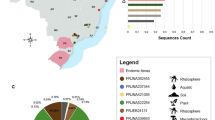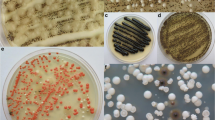Abstract
The environmental isolation of opportunistic pathogenic black yeasts, which are responsible for a wide spectrum of human infections, is essential to understanding the ecology of clinical fungi. Extreme outdoor environments polluted with aromatic hydrocarbons support the growth of black yeasts in unlikely places, such as railway sleepers. However, there are limited data concerning the diversity of these fungi growing on polluted railway sleepers. In this investigation, we examined 845 railway sleeper samples, obtained from 11 Turkish cities representing altitudes from 25 to 1,893 m, and inoculated the samples onto mycological media for the isolation of black yeasts. Ninety-four samples (11.1 %) yielded positive results for black yeast, with creosoted oak sleepers having a significantly higher number of isolates than concrete sleepers (p < 0.05). Identification based on the ribosomal DNA (rDNA) internal transcribed spacer region revealed the highest prevalence of Exophiala phaeomuriformis, followed by Exophiala dermatitidis, Exophiala heteromorpha, Exophiala xenobiotica, and Exophiala crusticola. This study revealed that railway sleepers harboring black yeasts were predominantly (>75 %) populated with thermophilic species. We observed that altitude might have a significant effect on species diversity. Briefly, E. phaeomuriformis exhibited growth over a wide altitude range, from 30 to 1,893 m. In contrast, E. dermatitidis had a remarkable aversion to low altitudes and exhibited maximum growth at 1,285 m. In conclusion, we speculate that one can predict what species will be found on railway sleepers and their probability and that species diversity primarily depends on sleeper type and altitude height. We believe that this study can contribute new insights into the ecology of black yeasts on railway sleepers and the railway factors that influence their diversity.



Similar content being viewed by others
References
de Hoog GS, Guarro J, Figueras MJ, Gené J (2014) Atlas of clinical fungi. 4th CD-ROM ed. CBS-KNAW Fungal Biodiversity Centre, Utrecht/Universitat Rovira i Virgili, Reus.
Woo PC, Ngan AH, Tsang CC, Ling IW, Chan JF, Leung SY, Yuen KY, Lau SK (2013) Clinical spectrum of Exophiala infections and a novel Exophiala species, Exophiala hongkongensis. J Clin Microbiol 51:260–267
Zeng JS, Sutton DA, Fothergill AW, Rinaldi MG, Harrak MJ, de Hoog GS (2007) Spectra of clinically relevant Exophiala species. J Clin Microbiol 45:3713–3720
Vicente VA, Attili-Angelis D, Pie MR, Queiroz-Telles F, Cruz LM, Najafzadeh MJ, de Hoog GS, Zhao J, Pizzirani-Kleiner A (2008) Environmental isolation of black yeast-like fungi involved in human infection. Stud Mycol 61:137–144
Sudhadham M, Pirakitsin S, Sivichai S, Chaiyarat R, Dorrestein GM, Menken SB, de Hoog GS (2008) The neurotropic black yeast Exophiala dermatitidis has a possible origin in the tropical rain forest. Stud Mycol 61:145–155
Zhao J, Zeng J, de Hoog GS, Attili-Angelis D, Prenafeta-Boldú FX (2010) Isolation and identification of black yeasts by enrichment on atmospheres of monoaromatic hydrocarbons. Microb Ecol 60:149–156
Dogen A, Kaplan E, Ilkit M, de Hoog GS (2013) Massive contamination of Exophiala dermatitidis and E. phaeomuriformis in railway stations in subtropical Turkey. Mycopathologia 175:381–386
Dogen A, Ilkit M, de Hoog GS (2013) Black yeast habitat choices and species spectrum on high altitude creosote-treated railway ties. Fungal Biol 117:692–696
Lian X, de Hoog GS (2010) Indoor wet cells harbour melanized agents of cutaneous infection. Med Mycol 48:622–628
Zalar P, Novak M, de Hoog GS, Gunde-Cimerman N (2011) Dishwashers—a man-made ecological niche accommodating human opportunistic fungal pathogens. Fungal Biol 115:997–1007
Dogen A, Kaplan E, Oksuz Z, Serin MS, Ilkit M, de Hoog GS (2013) Dishwashers are a major source of human opportunistic yeast-like fungi in indoor environments in Mersin, Turkey. Med Mycol 51:493–498
Matos T, de Hoog GS, de Boer AG, de Crom I, Haase G (2002) High prevalence of the neurotrope Exophiala dermatitidis and related oligotrophic black yeasts in sauna facilities. Mycoses 45:373–377
Prenafeta-Boldú FX, Summerbell R, de Hoog GS (2006) Fungi growing on aromatic hydrocarbons: biotechnology’s unexpected encounter with biohazard? FEMS Microbiol Rev 30:109–130
Seyedmousavi S, Badali H, Chlebicki A, Zhao J, Prenafeta-Boldú FX, de Hoog GS (2011) Exophiala sideris, a novel black yeast isolated from environments polluted with toxic alkyl benzenes and arsenic. Fungal Biol 115:1030–1037
Turin L, Riva F, Galbiati G, Cainelli T (2000) Fast, simple and highly sensitive double-rounded polymerase chain reaction assay to detect medically relevant fungi in dermatological specimens. Eur J Clin Invest 30:511–518
Hall TA (1999) BioEdit: a user-friendly biological sequence alignment editor and analysis program for Windows 95/98 NT. Nucl Acids Symp Ser 41:958
Tamura K, Peterson D, Peterson N, Stecher G, Nei M, Kumar S (2011) MEGA5: molecular evolutionary genetics analysis using maximum likelihood, evolutionary distance, and maximum persimony methods. Mol Biol Evol 28:2731–2739
Zeng J, Feng P, Gerrits van den Ende AHG, Xi L, Harrak MJ, de Hoog GS (2014) Multilocus analysis of the Exophiala jeanselmei clade containing black yeasts involved in opportunistic disease in humans. Fungal Divers 65:3–16
Duarte AP, Pagnocca FC, Baron NC, Melhem Mde S, Palmeira GA, de Angelis DF, Attili-Angilis D (2013) In vitro susceptibility of environmental isolates of Exophiala dermatitidis to five antifungal agents. Mycopathologia 175:455–461
de Hoog GS, Zeng JS, Harrak MJ, Sutton DA (2006) Exophiala xenobiotica sp. nov., an opportunistic black yeast inhabiting environments rich in hydrocarbons. Antonie Van Leeuwenhoek 90:257–268
Isola D, Selbmann L, de Hoog GS, Fenice M, Onofri S, Prenafeta-Boldú FX, Zucconi L (2013) Isolation and screening of black fungi as degraders of volatile aromatic hydrocarbons. Mycopathologia 175:369–379
Aoyama Y, Nomura M, Yamanaka S, Ogawa Y, Kitajima Y (2009) Subcutaneous phaeohyphomycosis caused by Exophiala xenobiotica in a non-Hodgkin lymphoma patient. Med Mycol 47:95–99
Bates ST, Reddy GSN, Garcia-Pichel N (2006) Exophiala crusticola anam. nov. (affinity Herpotrichillaceae), a novel black yeast from biological soil crusts in the Western United States. Int J Syst Evol Microbiol 56:2697–2702
Sudhadham M, de Hoog GS, Menken SB, Gerrits van den Ende AHG, Sihanonth P (2010) Rapid screening for genotypes as possible markers of virulence in the neurotropic black yeast Exophiala dermatitidis using PCR-RFLP. J Microbiol Methods 80:138–142
Kondori N, Gilljam M, Lindblad A, Jönsson B, Moore ER, Wennerås C (2011) High rate of Exophiala dermatitidis recovery in the airway of patients with cystic fibrosis is associated with pancreatic insufficiency. J Clin Microbiol 49:1004–1009
Acknowledgments
The authors would like to thank Professor Süleyha Hilmioglu-Polat for the assistance with the collection of the Izmir samples, Associate Professor Aylin Dogen for conducting the physiological analysis, and Professor Refik Burgut for the statistical analysis of the study data. The authors would also like to thank the staff of the CBS-KNAW Fungal Biodiversity Centre collection service, specifically Mrs. Trix Merkx and Mr. Gerard Verkleij, for processing several of the Exophiala isolates.
Conflict of Interest
The authors report no conflicts of interest. The authors alone are responsible for the content and composition of this manuscript.
Author information
Authors and Affiliations
Corresponding author
Rights and permissions
About this article
Cite this article
Gümral, R., Tümgör, A., Saraçlı, M.A. et al. Black Yeast Diversity on Creosoted Railway Sleepers Changes with Ambient Climatic Conditions. Microb Ecol 68, 699–707 (2014). https://doi.org/10.1007/s00248-014-0459-5
Received:
Accepted:
Published:
Issue Date:
DOI: https://doi.org/10.1007/s00248-014-0459-5




